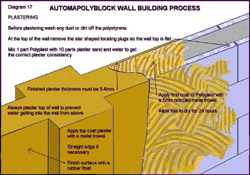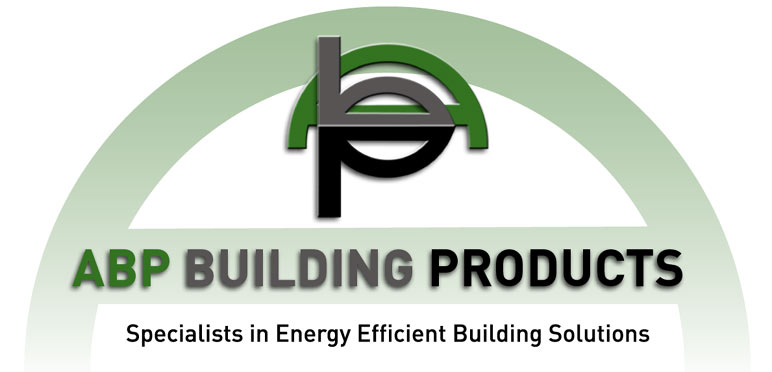POLYPLAST
EXPANDED
POLYSTYRENE PLASTER SYSTEM
INTRODUCTION
Whilst expanded polystyrene (EPS) in use
has many excellent attributes it often needs
ancillary products such as plasters, coatings
and glues to ensure its successful application
in the building industry.
Polyplast plaster provides protection and impact
resistance to EPS used in applications such
as walls, ceilings and mouldings.
|
 |
PRODUCT
DESCRIPTION
Polyplast is a combination of water based acrylics
and short length fibre that when mixed with plaster
sand forms a workable plaster mix that is easy to
apply to EPS, does not shrink or stress crack, has
excellent adhesion, is long lasting and provides the
necessary impact resistance.
There are 3 products in the range:
POLYPLAST - which is most commonly used at
a standard mix ratio of 1 part Polyplast to 10 parts
plaster sand.
POLYPLAST 'W '- which is a diluted version
Polyplast and is used where plaster sands are excessively
dry to facilitate the mixing process. Mix ratio is
1 part Polyplast 'W' to 7 parts plaster sand.
POLYPLAST 'C' - uses a different, cement
compatible, acrylic resin system to allow cement addition
to the mix to speed up the drying. Mix ratio is 1
part Polyplast 'C' to 1 part cement to 10 parts plaster
sand.
Polyplast 'C' is for use in areas of high humidity
or high rainfall where the drying and cure time of
the plaster is likely to be inhibited.
PRODUCT
BENEFITS
Excellent
adhesion to EPS
Polyplast was formulated to provide a product that
has good long term adhesion to EPS. Polyplast provides
a chemical key to the polystyrene surface.
Resistance to cracking
Polyplast does not shrink crack. The elimination of
cement from the mix eliminates any shrinking on drying.
As Polyplast retains some flexibility it resists cracking
associated with building movement.
Easy to mix, easy
to apply
Polyplast can be easily mixed by hand although mechanical
mixing is recommended. The product is easy to apply
by conventional plastering methods and can be straight
edged if required.
Natural appearance
Polyplast takes on the colour of the plaster sand
used giving a 'natural' appearance to the wall or
building if left unpainted.
Water
repellent
Although Polyplast is not water resistant due to the
high sand loading it does have water repellent properties.
If the resin to sand ratio is increased the water
repellancy of the product increases.
Impact resistance. Once full cured Polyplast provides
a tough, hard surface giving excellent impact resistance
to the EPS.
Versatile
Although Polyplast was developed specifically for
application onto EPS it can be used as a decorative
finish onto cement, brick and concrete. Due to the
sand filler loading and inherent flexibility it can
be used as a filler coat to bridge and hide cracks.
Long lasting
The resins used in Polyplast are high quality water
based acrylics which resist UV degradation and weathering.
Cost competitive
Polyplast plaster at 6mm thickness is cost competitive
against normal sand cement plasters at 15-20mm thickness.
FINISHING
OF PLASTERED WALLS
'Natural' appearance
Polyplast walls can be left unpainted with the finished
wall taking on the colour of the plaster sand used.
To maintain a uniform finish colour ensure the plaster
sand comes from the same source and that sufficient
quantities are mixed in one batch to plaster an entire
wall section or panel. Slight colour variances can
be expected from mix to mix even when the sand comes
from the same source.
Sealers
To improve the water resistance of the plaster clear
sealers can be applied to Polyplast. Sealers tend
to darken the plaster slightly.
Two sealer options are available from ABP Building
Products:
1) Dilute Polyplast with 4 parts of water and apply
by brush, roller or spray.
Do not use a higher resin to water ratio as this will
not provide a transparent film and the result will
be a slightly milky finish.
2) Use ABP's Plasterseal which is a clear styrene
acrylate sealer.
Properties of Plasterseal:
| UV
Resistance: |
Excellent |
| Water
Resistance: |
Excellent |
| Colour:
|
Transparent |
| Coverage: |
10-12m2/litre |
Paint
All commonly used exterior and interior paints can
be applied to Polyplast walls.
SYSTEM APPLICATION
1.Measure
area to be plastered. At the thickness recommended
(5-6mm) coverage of Polyplast will be 1lt per 2 sq
m of wall.
2.
Mix the Polyplast with plaster sand only at the ratio
1:10. The easiest way to do this is to use a 25lt
plastic bucket - 1 bucket of Polyplast to 10 buckets
of sand.
3.
Mix thoroughly, mixing in a concrete mixer is best
practice to get a uniform mix.
4.
If viscosity of mix is too thin add more sand and
if too thick add more Polyplast.
5.
It is easiest to plaster in two steps:
• Step 1 - using a 5mm notched trowel apply
a 'scratch' coat over the entire surface. This can
be done quickly. Allow to dry overnight
• Step 2 - using a metal float apply a smooth
finishing coat over the notched surface. Final finishing
is best done with a wooden or rubber float using water
sparingly on the surface.
The advantages of plastering this way is that the
notching provides a mechanical key for the finishing
plaster (it is difficult to apply a thick plaster
coat to expanded polystyrene due to the smooth finish)
and the 5mm notches provide a template to control
the final plaster thickness to 5-6mm.
6. As well as finishing with a rubber or wooden float,
finishing can be done with a brush or Tyrolean machine.
7.
Polyplast
can be painted with all types of decorative paints.
8.
In areas with excessively high rainfall or high humidity
it is recommended that a clear sealer is applied to
any unpainted Polyplast surfaces.
9.
Polyplast plaster takes up to 7 days to achieve full
cure and if it rains in this period some softening
of the plaster will be noted. Once dry the plaster
will reharden and the curing process continue.
When plastering in areas with high humidity the
drying and curing of Polyplast may be retarded.
To speed the drying process it is recommended that
an alternative product Polyplast 'C' is used as
this allows some cement to be used in the plaster
mix without any compromise to performance. The recommended
mix ratio is: 1 part Polyplast 'C': 1 part cement:
10 parts plaster sand.
PRODUCT SPECIFICATION
PRODUCT
|
PROPERTY |
MEASUREMENT |
POLYPLAST |
S.G. |
1,04 |
|
Viscosity |
95KU |
|
Solids |
52
+/- 2% |
|
Appearance |
Milky
white liquid |
|
|
|
POLYPLAST'W' |
S.G. |
1 |
|
Vicosity |
61ku |
|
Solids |
39
+/- 2% |
|
Appearance |
Milky
white liquid |
|
|
|
POLYPLAST'C'
|
S.G. |
1 |
|
Visocsity |
60ku |
|
Solids |
47
+/- 2% |
|
Appearance
|
Milky
white liquid |
 
|




